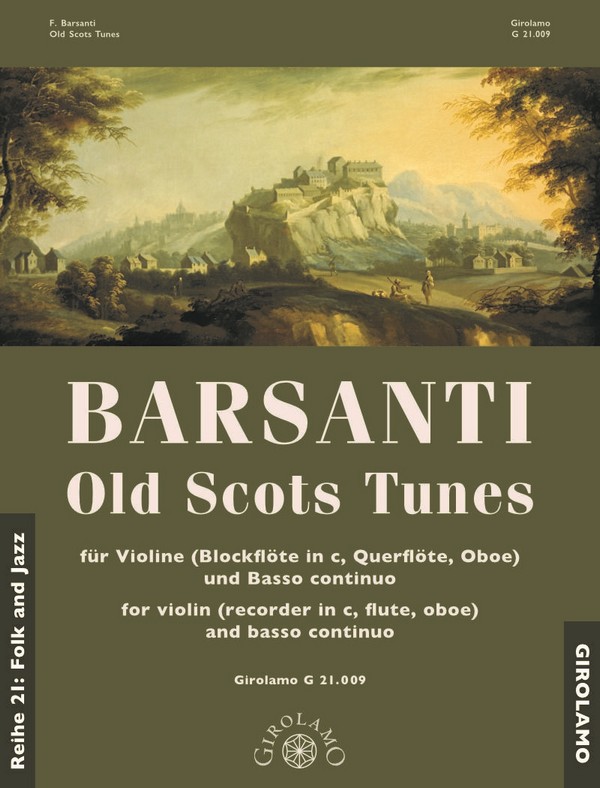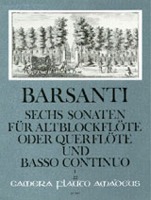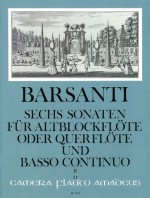Old Scots Tunes. Per violino (flauto dolce, traverso o oboe) e basso continuo. Girolamo Musikverlag
BARSANTI Old Scots Tunes. Per violino (flauto dolce, traverso o oboe) e basso continuo. Girolamo Musikverlag
€18.00
Recorder players are familiar with the name Francesco Barsanti and greatly appreciate his six fine sonatas Opus 1 for recorder and basso continuo, whereas other musicians and experts in Baroque music may never even have heard of his name or his works. This may well be because Barsanti – although a versatile and capable composer, instrumental teacher, instrumentalist and copyist, who would certainly have been able to rise to greater fame – preferred to stay out of the limelight.
We have very little evidence about the life of Francesco Barsanti. However, thanks to recent research by Jasmin Cameron and Michael Talbot1, we now have some new facts and further conjecture extending beyond what we already know from the historical source according to John Hawkins2.
Francesco Maria Barsanti was born in around 1690 in Lucca and first studied Law at the University of Padua without being matriculated. He then taught himself to play the recorder and probably the transverse flute, as well as the oboe. In 1724, Barsanti went to London, following the demand for Italian musicians in England. Here, he worked as an instrumental and composition teacher for various distinguished personalities and later also achieved a high reputation as a composer. It seems likely that he also helped out in the Italian Opera Orchestra during this period. From 1735 to 1743, Barsanti lived in Edinburgh, where in 1742 the present work was printed with the title:
A / COLLECTION / OF / OLD SCOTS TUNES /
With the Bass / FOR / VIOLONCELLO or HARPSICHORD: /
Set and most humbly Dedicated, to /
THE RIGHT HONOURABLE / THE LADY ERSKINE, /
BY / FRANCIS BARSANTI. / EDINBURGH, /
Printed by ALEXANDER BAILLIE & sold by
Messrs HAMILTON & KINCAID. / Price 2 sh:6
In 1743, Barsanti returned to London, where he spent some of his time working as a copyist for Handel. After this, he probably spent several years in the Netherlands, and can be traced back to London from 1750. From the age of 70, Barsanti steadily reduced his musical activities. In 1772, he suffered a stroke and died in London on 30 April 1775.
In his introduction to the Old Scots Tunes, Barsanti writes as follows:
Having discovered, in several ancient Scots tunes, an Elegance and Variety of Harmony equal to the Compositions of the most celebrated Masters of those Times; at the Desire of several Gentlemen of Taste, I applied myself to do Justice to those ancient Compositions, by a proper and natural Bass to each Tune, with the strictest regard to the Tune itself, and without any Alteration of the Tune to accommodate it to the Bass. […]
We will probably never know which sources Barsanti used for this work. 21 of the 30 songs chosen by Barsanti are contained in W. Thomson’s Orpheus Caledonius3, published in 1733. However, there are many deviations in rhythm and ornaments, and even the melodies frequently differ. A similar picture emerges in comparison with other publications of Scottish music in the years preceding 1742. This suggests that Barsanti did not use written sources, but instead based his work on live renderings by a Scottish musician. In a second step, he added his own sensitive and sometimes contrapuntal basso continuo accompaniment, which is unparalleled in its artistry. It must be noted that these settings were later used in countless publications, sometimes with slight variations, but with no acknowledgement of Barsanti as the original composer.
Barsanti provides no information concerning the melody instrument to be used in these compositions. However, the fact that he used b° or b-flat° in two of the pieces speaks for the violin. Because 28 of the pieces do not go below c1, they are equally playable on recorders in c, oboe, or the modern flute. In 25 of the pieces, the lowest note is d1, which makes them suitable for the transverse flute.
Two scans of the 1742 Baillie edition are available for download on the web. The exact location of the IMSLP copy4 is not noted. The final page of this edition containing numbers 29 and 30 is missing. In the copy held in the Glen Collection of the National Library of Scotland, Edinburgh,5 there is no introduction. These two otherwise identical sources were used for this new edition. Any amendments by the editor are marked. The editor’s report lists the essential error corrections. Only wrongly-positioned slurs and missing flags on grace notes were corrected without comment. The basso continuo realization by Yo Hirano may be helpful for players less versed in accompanying techniques.
Barsanti uses the customary signs for trills and mordents and, rarely, the English trill sign (=). Appoggiaturas, acciaccaturas, cadents etc. are generally written out, but Barsanti sometimes uses an upwards diagonal line to indicate two grace notes from below. In general, most appoggiaturas should be played on the beat for harmonic reasons.
Translation: Catherine Taylor
Celle, August 2021, Franz Müller-Busch
1 Cameron, Jasmin, and Michael Talbot: A Many-Sided Musician: The Life of Francesco Barsanti (c. 1690–1775) Revisited. In: Recercare vol. 25, no. 1/2, 2013, p. 95–154
2 Hawkins, John: A general history of the science and practice of music, London 1776, vol. V, p. 371–372
3 Thomson, Willam: Orpheus Caledonius, vol. I and II, London 1733 – https://digital.nls.uk/special-collections-of-printed-music/archive/91519908
5 https://digital.nls.uk/special-collections-of-printed-music/archive/102744454
Content:
| 1 – Dumbarton’s Drums | 16 – Fife and all the Lands about it |
| 2 – Kat Oggie | 17 – Peggy I must love thee |
| 3 – Ettrick Banks | 18 – Logan water |
| 4 – Lochaber | 19 – Pinkie House |
| 5 – The Lass of Peatie’s mill | 20 – The Sutours of Selkirk |
| 6 – The Highland Laddie | 21 – Cromlet’s Lilt |
| 7 – Busk ye busk ye my bonny bride | 22 – Bonny Jean |
| 8 – The last time I came o’er the moor | 23 – Thro’ the Wood Laddie |
| 9 – Corn riggs are bonny | 24 – Clout the Caldron |
| 10 – Waly Waly | 25 – O dear Mother, what shall I do |
| 11 – Johnny Faa | 26 – Broom of Corvden knons |
| 12 – Lord Aboyne’s welcome or Cumbernauld house | 27 – Where Helen lies |
| 13 – The Bush aboon Traquair | 28 – The bonny Earl of Murray |
| 14 – To danton me | 29 – Gilderoy |
| 15 – The Birks of Envermay | 30 – The Mill Mill_O |
Solamente clienti che hanno effettuato l'accesso ed hanno acquistato questo prodotto possono lasciare una recensione.
Ti potrebbe interessare…
-
BARSANTI Sonata for Treble (Alto) Recorder in C-major. Dowani
CD BASE FLAUTO DOLCE €29.20 Aggiungi al carrello














Recensioni
Ancora non ci sono recensioni.